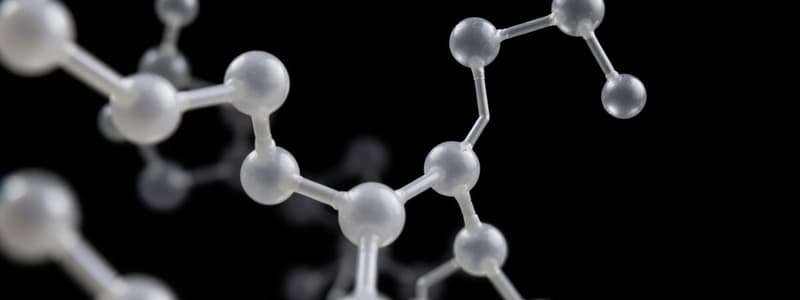Podcast
Questions and Answers
What is one of the primary reasons for studying carbohydrates?
What is one of the primary reasons for studying carbohydrates?
- They are exclusively found in animal tissues.
- They enhance the absorption of vitamins.
- They are the main source of energy for tissues. (correct)
- They contain high levels of protein.
Which of the following is NOT a function of carbohydrates?
Which of the following is NOT a function of carbohydrates?
- Formation of structural elements.
- Storage of genetic information. (correct)
- Formation of glycolipids and glycoproteins.
- Energy production.
What percentage of our diet do carbohydrates constitute?
What percentage of our diet do carbohydrates constitute?
- 45%
- 75%
- 60% (correct)
- 30%
Monosaccharides are classified as which type of carbohydrate?
Monosaccharides are classified as which type of carbohydrate?
Which process in plants leads to the production of carbohydrates?
Which process in plants leads to the production of carbohydrates?
What distinguishes monosaccharides from other sugars?
What distinguishes monosaccharides from other sugars?
Which of the following classifications refers to monosaccharides containing 5 carbon atoms?
Which of the following classifications refers to monosaccharides containing 5 carbon atoms?
What is an example of an aldotriose?
What is an example of an aldotriose?
What role does ribose play in biological systems?
What role does ribose play in biological systems?
Which of the following refers to the classification based on the presence of ketone or aldehyde groups in monosaccharides?
Which of the following refers to the classification based on the presence of ketone or aldehyde groups in monosaccharides?
Flashcards are hidden until you start studying
Study Notes
Carbohydrate Chemistry
- Carbohydrates are essential organic compounds, characterized by three features
- They provide a primary source of energy for tissues such as the brain, muscles, and erythrocytes
- They are widely distributed in plants and animals
- They are important for energy production, forming structural elements in animal and plant cells, forming glycolipids and glycoproteins, both of which are involved in cell membrane structure and the matrix between tissues
Classification of Carbohydrates
- Divided into monosaccharides, disaccharides, oligosaccharides, and polysaccharides
Monosaccharides
- The simplest type of sugar
- Formed of a single sugar unit
- Cannot be hydrolyzed further
- Classified by the presence of an aldehyde or ketone group and the number of carbon atoms.
Monosaccharide Classifications
- Aldoses: Possess an aldehyde group (-CHO)
- Ketoses: Possess a ketone group (-C=O)
- Trioses: Contain 3 carbon atoms
- Aldotrioses: Examples include glyceraldehyde ("glycerose")
- Ketotrioses: Examples include dihydroxyacetone
- Tetroses: Contain 4 carbon atoms
- Aldotetroses: Examples include erythrose
- Ketotetroses: Examples include erythulose
- Pentoses: Contain 5 carbon atoms
- Aldopentoses: Examples include ribose, arabinose, xylose, and lyxose
- Ketopentoses: Examples include ribulose and xylulose
- Hexoses: Contain 6 carbon atoms
- Aldohexoses: Examples include glucose, mannose, and galactose
- Ketohexoses: Examples include fructose
Importance of Pentoses
- Ribose and deoxyribose form the structural basis of nucleic acids RNA and DNA
- Ribose forms part of ATP, GTP, and other high energy phosphate compounds
- Ribose forms part of coenzymes NAD, NADP, and flavo-proteins
- Ribose phosphate and ribulose phosphate are intermediates in the pentose phosphate pathway, a minor pathway for glucose oxidation
- Arabinose and xylose are constituents of glycoproteins in plants and animals
- Lyxose is a constituent of lyxoflavin, isolated from human heart muscle
- Xylulose is an intermediate in the uronic acid pathway, a minor pathway for glucose oxidation
Importance of Hexoses
- Glucose is the most important sugar in the body
- Main sugar in the blood
- One of the major sources of energy in the body
- It is converted to other carbohydrates in the liver and other tissues such as glycogen, galactose, ribose, and fructose
- Fructose (fruit sugar)
- Can be converted into glucose in the liver
- Main sugar in semen
- Galactose
- Converted to glucose in the liver
- Synthesized in mammary glands to make lactose (milk sugar)
- Mannose
- Constituent of many glycoproteins
Ring (Cyclic) Structure of Sugars
- The simple open chain formula for sugars doesn’t explain some reactions, for example, glucose with an aldehyde group, does not give all the reactions of an aldehyde. This suggests that the -CHO group is masked or combined in some way
Formation of Ring Structures
- Sugars with an aldehyde group undergo hydration to form an aldenol group (alcohol)
- Intra-molecular reactions occur between the -OH of the aldenol group and the -OH group of C4 or C5 to form a ring structure (hemiacetal structure)
- The carbonyl group becomes an asymmetric carbon atom
- If the remaining -OH is on the right side, it is an α-sugar
- If the remaining -OH is on the left side, it is a β-sugar
Pyranose and Furanose
- 1-5 ring form is called pyranose, resembling an organic compound called pyran, e.g., α and β glucopyranose
- 1 -4 rind form is called furanose, resembling an organic compound called furan, e.g., α and β glucofuranose
Haworth and Chair Forms
- Cyclic structures of sugars can exist in Haworth or chair forms
- Haworth formula:
- All -OH groups on the right side of the old ring structure are written downwards
- All -OH groups on the left side of the old ring structure are written upwards
- These rules are reversed at CH2-OH groups, e.g., the last carbon atom of glucose that is attached to oxygen (C4 in furanose, C5 in pyranose)
Studying That Suits You
Use AI to generate personalized quizzes and flashcards to suit your learning preferences.




